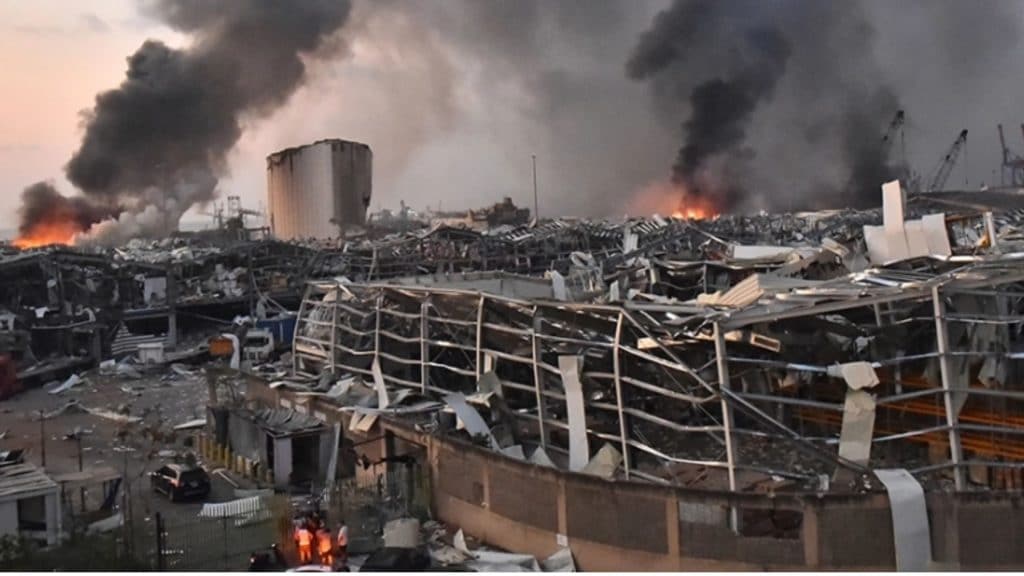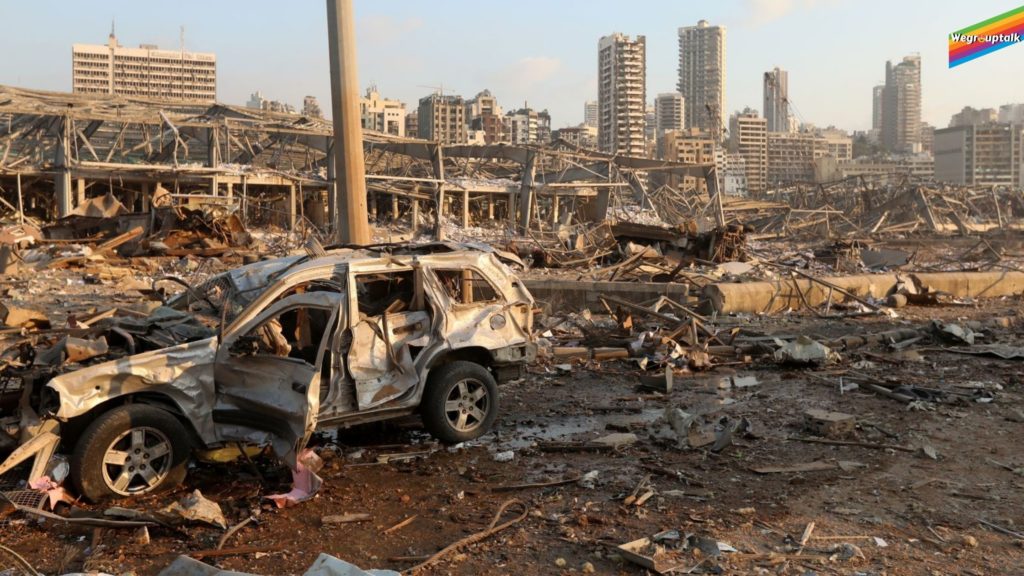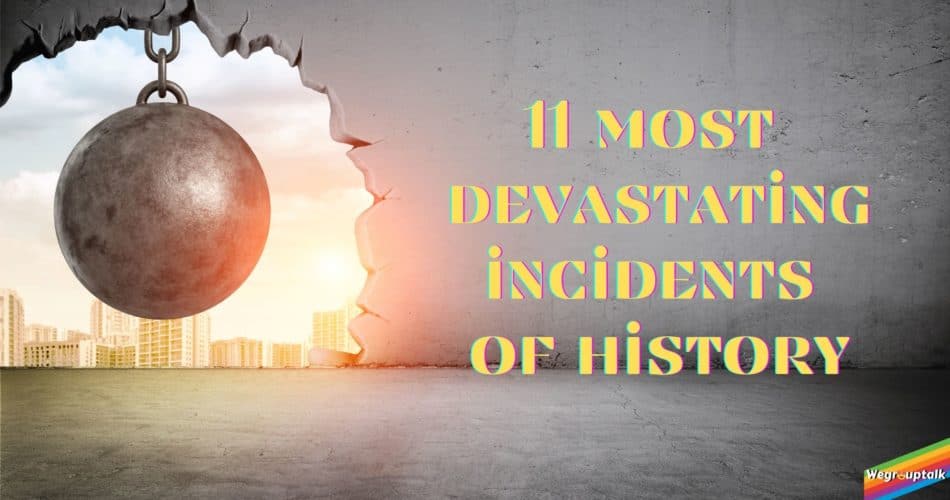The Catastrophic moments occurred time and again worldwide, which led to a tremendous loss in property, human health, destruction of crops, etc. When these incidents occur, human power becomes unable to protect themselves. If we look back in the past, disasters like wildfires, earthquakes, storms, human attacks, deadly diseases had changed the world within no time. The bombing on Hiroshima and Nagasaki killed lakhs of lives; the heat generated from bombing destroyed the infrastructure around 4.4 sq. miles and instantly killed approximately 70000 people. The children born with defects and the effects of bombing remains still there. These devastating incidents not only took millions of lives but vandalised the lands also.
1556 Shanxi Earthquake
On 23 January 1556, an earthquake of magnitude 8.0 epic entered at 34°30’01” N, 109°18’00” E occurred in Northern China’s Shaanxi province. The magnitude of the earthquake was not the maximum ever recorded. However, it is considered to be the deadliest incident ever occurred in human history as approx. 8,30,000 people lost their lives. Mountains in the most affected region were almost levelled, and the havoc wrecking earthquake caused ground fissures up to the depth of 66 feet. Ming Dynasty, reigning dynasty then, toppled as some of the worst-hit countries lost about 60%.
The important structures and monuments which had both devotional and cultural value were destroyed. The annals of China describe the earthquake as, “In the winter of 1556, an earthquake catastrophe occurred in the Shaanxi and Shanxi Provinces. Roads were destroyed. Mountains and rivers changed places. The ground suddenly rose and formed new hills in some places, or it sank abruptly and became new valleys. In some areas, the ground broke, new gullies appeared, or a stream burst out instantly. Huts, temples, houses, and city walls collapsed all of a sudden”.
Bhopal Gas Tragedy
A gas tragedy that is impossible for Indians to forget occurred in the intervening night of 2-3 December 1984 in Bhopal, Madhya Pradesh. The toxic gas, methyl isocyanate(MIC), leaked from tank E610 of Union Carbide India Limited (UCIL) pesticide plant. It is referred to as the world’s worst industrial disaster. The tank E610 contained 42 tons MIC, of which about 30 tons spilt out from the tank in the first hour of leakage.
People of Bhopal were made aware of the leak by the gas itself. More than 5 lakh people got exposed to the deadly gas. According to an official statement, 3787 people died in the incident, and more than 5 lakh received injuries. However, non-official sources claim the opposite. Karuna Raina who leads Bhopal gas campaign, says, “At least 7000 people were killed within first 72 hours of the leak”.
Moreover, as of her, about 25,000 people have lost their lives since the incident. Pulmonary oedema, choking and circulatory collapse was referred to as the main causes of deaths. Around 1,20,000 people still suffer from ailments caused due to the leakage as stated by Bhopal Medical Appeal, a U.K. based charity.
Hiroshima and Nagasaki Bombings
The two names are familiar to almost everybody; they give a clear picture of war catastrophe. The United States bombed (bomb namely, Little Boy) Hiroshima, a manufacturing centre of around 3,50,000 people, on 6 August 1945. The heat generated from the blast burned almost everything within 4.4 sq. miles and instantly killed about 70,000. The infrastructure in the area seemed never to exist. Despite this unimaginable damage caused to human lives and everything else valuable, Japan was reluctant to surrender in the ongoing World War II.
Adding salt to Japanese and lowering their morale to surrender, the U.S. used another nuke, Fat Man on 9 August 1945 on Nagasaki. Although the second atomic bomb was powerful than that of Hiroshima one, the mountains fencing Nagasaki reduced the explosion’s effect to 2.2 sq. miles. Some 40,000 civilians lost their lives immediately. An estimate of the total killings suggests that about 1.29 – 2.26 lakh civilians died in the twin attacks.
The 1970 Bhola Cyclone
Bhola Cyclone, the deadliest tropical cyclone ever recorded struck Ganges Delta on 11 November 1970. Ganges Delta comprising of East-Pakistan(now Bangladesh) and India’s West Bengal lost approx. 5,00,000 human lives. The cyclone winds reached its peak 185 km/hr (115 mph) and started devastating Bangladeshi offshore islands, villages, crops and almost everything on its way. Upazila, Tazumuddin remained the worst-hit area losing about 45% (nearly 1,67,000) population.
The Ganges Delta suffered damage worth $86.4 million (1970 USD, 579.83 million Present USD). Coastal areas faced the major brunt of the devastation. Fishing Industry’s 65% was destroyed, and around 59% fisherman population vanished. The survivors in the cyclone were most severely injured.
9/11 Terrorist Attack
Terrorists crashed two Boeing planes into the twin towers of world trade centre collapsing both the skyscrapers. Another hijacked plane crashed into the pentagon military headquarters while the 4th hijacked plane crashed into Pennsylvania’s rural field. The overall death toll is estimated at 2,996 comprising of 78 country citizens. Alone 2,763 died at world trade centre including 343 firefighters and 60 other police personnel. Some 25,000 people suffered injuries—hefty worth of about $10 billion resulted from infrastructural and property damage.
However, according to Institute for the analysis of Global Security states, “Counting the value of lives lost as well as property damage and lost production of goods and services, losses already exceed $100 billion. Including the loss in stock market wealth- the market’s estimate arising from expectations of lower corporate profits and higher discount rates for economic volatility- the price tag approaches $2 trillion”.
2013 Rana Plaza Collapse
24 April 2013 appeared as doomsday for Bangladesh as the country witnessed the deadliest structural failure accident in modern human history. It also tops the deadliest garment-factory disasters in history. An eight-story building housing five garment factories collapsed, named Rana Plaza, resulting in 1,134 deaths and 2,500 injuries. It is said that it took less than 60 seconds to collapse. Half of the victims in the incident were women.
Besides, government rescue operations, volunteer groups and individuals joined hands to save more and more lives from the rubble and bring out the dead ones. The search and rescue operations continued for 19 days. The disaster left behind only despair and mourning for the families of hundreds of victims who were sole bread earners for their loved ones.
The 1975 Banqiao Reservoir Dam Failure
The deadliest dam failure ever occurred when Banqiao dam on Ru river of China’s Zhumadian city released massive water volumes after being hit by typhoon Nina and successive rains on 8 August 1970. The overall death toll is estimated between 85,600 – 2,40,000. More than 6.8 million houses collapsed. About 10.15 million people got affected. 12,000 sq. km (3 million acres) area was under the influence of the disaster. Billions of m³ of water gave way from the dams. The typhoon Nina, engineering mistakes, wrong policies and communication fragility were key factors responsible for the catastrophe.
Lebanon explosive attack
It was the 4 August 2020; the blast broke out in the early evening at the warehouse 12 near the port of Lebanon capital city Beirut. The warehouse contains the ammonium nitrate used for agricultural fertilizers and is used as an explosive. The ammonium nitrate is highly flammable, and when it comes into contact with fire, it explodes and releasing the toxic gases including nitrogen oxides, ammonia which is hazards for humans. The blast’s strength was so high that it destroyed Lebanon’s whole capital city and the Beirut’s near areas feel the attack. The magnitude of the blast heard 240 km away in the eastern areas of Lebanon.

According to the WHO report, about more than 178 people were killed, 6500 injured and 3 lakh people became homeless. The attack also damaged the city’s critical health infrastructure and medical supplies; the people suffer from many health care benefits. During the incident, the huge smoke produced at the spot, After a moment the fire broke out and dismantled the whole city, the blast shattered glass windows and furniture of all buildings near the port, the building slaps. Glass panels covered the site’s roads. They became the hindrance ambulances to carry the victims to the hospitals. The glass blowing in the air injured many people, and the smoke was still going up in the accident’s late hours.
One of the witnesses said, “I saw the fire, but I did not know the blast is going to happen, I went towards indoor, and suddenly I lost my hearing power for few seconds because I was very close at the spot, suddenly the glass going down from every building and the shattered all over the cars”. The people were already facing political disturbances in the country, and the current catastrophe covid-19 led the people to the economic crisis. Then the explosive attack made the people even poorer.

The Indian Ocean Earthquake and Tsunami
The Indian ocean and Tsunami is considered as one of the biggest devastating incident happening in the past. In the early morning of 26 December 2004, the earthquake broke out under the Indian ocean of magnitude 9.1 which triggered the huge amount of water towards the coastal areas known as Tsunami and the flooded water encapsulated whole flora fauna of the coastal areas. The fourteen countries became the victim of the incident in which more than 230,000 people were killed. Some coastal areas’ inhabitation was completely ruined, and the coast of damage was considered 10 billion dollars.
The tourists came from European countries towards the coastal areas, and beaches of Thailand, Sri Lanka, Indonesia and others coastal parts of the Indian ocean to protect themselves from chilli winter in the tropical areas also lost their lives in the catastrophe. The city of Banda Aceh near the north to Sumatra was very close to the powerful earthquake’s epicentre. Now the coastal has been rebuilt by many communities.
2014 Flooding in Jammu and Kashmir
It was the month of September 2014; The rain was continuously falling on the valley of j and k, the water in the river Jhelum had been continuously rising day by day, this raising of water in the river Jhelum spread the terror in the minds of people who live near the embankments of the river. The people lived very close to the river packed their necessary items and travelled towards the mountainous places to keep themselves from this catastrophe disaster. This situation in the valley created more terror among the people of the state.
Finally, the flood occurred that various cover districts of the state. According to the government reports, about 300 people were killed, 25 injured, and the huge property loss was identified. The sources said about 3.27 lakh hectors of agricultural land, 3.96 lakh hectors of horticultural land suffered a huge amount of loss because it was the time of harvesting, the staple food rice and apples had been riped. Lakhs of people got homeless, and this flooded water remains for long times in the wetlands. It had been estimated that the damage of the property is between 5000 to 6000 crores.
The valley is vulnerable to flooded disasters, but these devastating flooding in the valley are due to urbanization. The wetlands that act as a sponge for flooded water have been converted into the villages, shrinking river Jhelum’s width.
Chernobyl Nuclear Power Disaster
The official name of the Chernobyl nuclear power plant was v.i. Lenin Atomic power plant. The accident happened on 26 April 1986 at the Chernobyl nuclear power plant 15km away from Ukraine in the Soviet Union. The station was situated at the Pripyat also known as the atomic city of the Chernobyl which was constructed to make all the facilities available for the people who live in the city.
This worst accident has made a record in the history of nuclear power generation. The nuclear power station had four units, and each unit produces a power of 1000 megawatt. The plant was built to facilitate the power supply to the atomic city (Pripyat). The construction of the plant was started in 1970 and became functional in 1977. The incident broke out when the Engineers, controllers and workers of the station tested how the nuclear station can be controlled in an emergency when all our reactor controllers (which balances the station’s reaction) became functional less.
During the test, the engineers make some mistakes, such as violating the safety rules and the 26-year-old Senior Reactor Control Engineer Leonid Toptunov who made a mistake of switching from manual to automatic control of boron rods which were responsible for controlling the nuclear reaction. The rods were used faster as intended and as a result of all the rods had consumed.
The water that was used not only for controlling the reaction but also used for the nuclear reaction to generate power had converted into the steam at a very high rate, whole the water which was also used for cooling the nuclear reaction had been used in the short time, the mechanism failed to supply water for cooling the reaction to control the rapid production of steam. The room got full of steam due to which the roof of the room burns and the radioactive material exposed into the air. The sources said that at the initial explosion the two-person were killed, and 50 were killed in the disaster.
The government of the Soviet Union is unrevealed the incident to stop the panic. The Chernobyl world remained ignorant of the situation until the morning of 28 April 1986 when the sensor detected radiation levels on the air at Sweden’s Forsmark Nuclear power plant, 1000 km away from the Chernobyl power plant. The billions of dollars had been destroyed by this incident. The government had poured 1500 tons of sand on the station for controlling the radioactive radiations. The Chernobyl nuclear power station has been made a tourist spot where the people worldwide come and see the plant and the Pripyat city.
Conclusion
These devastating events are natural or human-made, natural disasters cannot be controlled, they occur at unusual times without the intervention of humans, but human-made devastating events can be controlled by controlling the spread of terrorism in the world, human safety laws should be strictly implemented, and if anyone is involved in the terror attacks, strict actions should be implemented against him so that we can control these dreadful events.
Follow us on FACEBOOK, INSTAGRAM and TWITTER to stay connected.
ALSO Read- Role of Technology in betterment and against nature.




